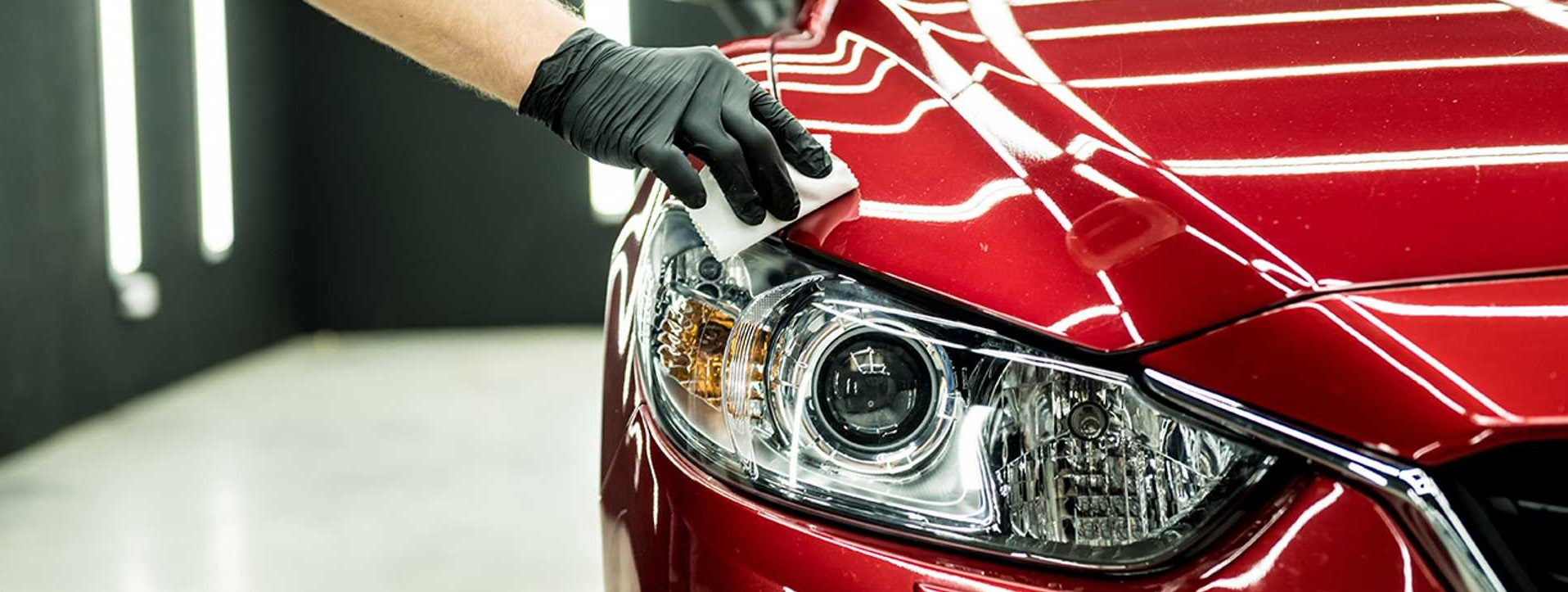Why Ceramic Coating Newark is a cost-effective investment for drivers in Newark
Discovering the Scientific Research Behind Car Ceramic Coating and Its Safety Characteristics
The science of car ceramic coating presents a remarkable research study in sophisticated vehicle protection. Composed mainly of silicon dioxide and polymers, these finishes develop a durable bond with automobile paint. This communication enhances resilience against ecological threats while supplying hydrophobic advantages. The intricacies of exactly how these coverings work and their long-term benefits continue to be much less understood. Ceramic Coating Newark. Unboxing these details discloses why ceramic layers are ending up being a favored selection for lorry care
What Is Ceramic Coating?
Ceramic coating is a liquid polymer that chemically bonds to the surface of an automobile's paint. This sophisticated safety layer enhances sturdiness and offers premium resistance to environmental variables. Unlike typical wax or sealants, which offer short-lived protection, ceramic layers create a lasting guard that can hold up against extreme conditions such as UV rays, acidic pollutants, and severe weather condition. When applied appropriately, the coating forms a hydrophobic surface, triggering water to grain and slide off, which aids in maintaining the automobile's tidiness. Additionally, it provides boosted gloss and deepness to the paint, making the automobile show up even more sleek and lively. The application process usually includes detailed surface area preparation, including cleansing and polishing, to ensure peak bonding. Therefore, ceramic layers are ending up being progressively prominent among car lovers and those seeking to shield their investments, guaranteeing to preserve the vehicle's visual appeal while reducing the frequency of upkeep.
The Make-up of Ceramic Coatings
The intricate formulation of ceramic coatings primarily is composed of silicon dioxide (SiO2), which is originated from all-natural resources like quartz and sand. This vital component gives the foundation for the coating's resilience and protective qualities. In enhancement to SiO2, ceramic finishes typically consist of various polymers and ingredients that enhance bond, adaptability, and resistance to ecological aspects. These compounds work synergistically to produce a robust barrier against contaminants such as dirt, chemicals, and UV rays.Furthermore, some solutions include titanium dioxide (TiO2) or other nanomaterials, which can boost the coating's hydrophobic homes, leading to better water repellency. The precise structure can differ considerably among manufacturers, impacting efficiency and longevity. Ultimately, the combination of these elements culminates in a protective layer that not just improves the aesthetic appeal of cars yet also serves to lengthen their life-span by shielding the surface from possible damages.
How Ceramic Coatings Job
Comprehending how ceramic coverings work includes exploring their chemical structure, which adds to their protective high qualities. The application procedure is vital for attaining excellent outcomes, while longevity and resilience elements establish the coating's effectiveness over time. With each other, these components highlight the benefits and efficiency of ceramic coverings for lorry security.
Chemical Make-up Explained
While numerous car owners seek durable security for their automobiles, the chemical make-up of ceramic coverings plays an essential role in their performance. These coverings primarily contain silicon dioxide (SiO2), which is derived from natural minerals. This substance forms a solid bond with the lorry's paint, developing a resilient, safety layer. Furthermore, numerous ceramic layers contain titanium dioxide (TiO2), enhancing their hydrophobic residential or commercial properties and resistance to UV rays. The existence of polysiloxanes can better enhance flexibility and resilience. With each other, these aspects contribute to the coating's capability to drive away water, dirt, and impurities, while additionally giving a high-gloss coating. Comprehending this chemical structure helps car owners appreciate the durable security offered by ceramic finishes.
Application Process Summary
Applying ceramic layers includes a meticulous process that ensures optimal bonding and defense for the lorry's surface. Initially, thorough cleansing and purification of the car's exterior are executed to remove dirt, crud, and previous waxes. This step validates that the surface is devoid of pollutants that could hinder attachment. Following this, the paint is frequently brightened to enhance quality and eliminate any blemishes. As soon as prepared, the ceramic coating is used in tiny sections making use of an applicator pad, permitting uniform protection. The coating is then left to heal, forming a solid chemical bond with the surface. Proper curing times and conditions are critical, as they verify the coating attains its optimum performance and protective top qualities.
Long Life and Resilience Variables
Ceramic finishes are designed to supply long-lasting defense via their sophisticated chemical composition, which creates a robust barrier against environmental impurities. The sturdiness of these finishings is influenced by factors such as the density of the application, the high quality of the product, and the conditions under which the vehicle is exposed. Top quality ceramic layers can last a number of years, standing up to scrapes, UV rays, view and chemical spots. Correct upkeep, including normal washing and regular reapplication, can even more boost durability. In addition, ecological factors like climate and exposure to pollutants can impact the life-span of the coating. Overall, when applied and preserved appropriately, ceramic finishings use extraordinary toughness, making them a popular choice for car enthusiasts looking for to maintain their car's look.
Hydrophobic Properties and Water Repellency
Hydrophobic buildings are a characteristic of quality car ceramic finishes, substantially enhancing the car's surface area performance. These finishes produce a molecular bond with the car's paint, causing a surface that pushes back water effectively. When water enters into call with a ceramic-coated surface, it beads up and rolls off, minimizing the amount of fluid that continues to be on the paint. This behavior not just adds to a visually pleasing look however likewise lowers the build-up of impurities such as dust, crud, and roadway salts.The enhanced water repellency results in easier cleaning and upkeep, as much less initiative is needed to get rid of undesirable materials. Furthermore, the hydrophobic nature of ceramic coatings helps in protecting against water places, which can mar the surface of uncoated surface areas. Overall, the consolidation of hydrophobic residential or commercial properties in ceramic finishings plays a vital duty in keeping the car's immaculate appearance while simplifying upkeep.
Defense Against Scratches and UV Damage
Car ceramic finishes provide significant protection against scrapes and UV damage. The scratch resistance system develops a long lasting layer that absorbs effects, while the UV shielding advantages assist maintain the vehicle's paint stability with time. With each other, these features add to a longer-lasting and aesthetically attractive coating.
Damage Resistance Device
Utilizing advanced innovation, ceramic finishes supply a robust shield against scratches and UV damages, boosting the long life and look of automobile surfaces. The scratch resistance device of these layers is attributed to their one-of-a-kind molecular framework, which develops a sturdy bond with the vehicle's paint. This bond creates a hard, safety layer that can absorb effects and stand up to abrasions. In addition, the smooth surface area of the coating reduces rubbing, making it difficult for impurities to stick and cause scratches. The chemical composition of ceramic layers typically consists of nanoparticles that enhance the safety layer, additional improving its durability. Automobiles treated with ceramic coverings exhibit markedly improved scratch resistance contrasted to traditional wax or sealants, guaranteeing a beautiful finish over time.
UV Shielding Advantages
The protective high qualities of ceramic layers prolong past scratch resistance to consist of considerable UV shielding advantages. These coverings produce a robust obstacle that shows dangerous ultraviolet rays, protecting the vehicle's paint and underlying products. Long term direct exposure to UV radiation can lead to fading, oxidation, and deterioration of the paint finish. By incorporating ceramic finishings, car see this here proprietors can effectively mitigate these dangers, preserving the aesthetic appeal and honesty of their cars. In addition, the UV obstructing residential or commercial properties add to improved longevity, minimizing the regularity of repainting and maintenance. Ultimately, the integration of ceramic finishes offers an extensive option for safeguarding vehicles from the destructive effects of sun exposure, making certain a continual, vivid look over time.
The Long life and Maintenance of Ceramic Coatings

Regularly Asked Questions
Can Ceramic Coating Be Applied to Any Sort Of Automobile?
Ceramic coating can be applied to different kinds that site of vehicles, consisting of automobiles, vehicles, and bikes. However, surface preparation and compatibility with particular products are necessary for perfect bond and effectiveness of the coating.
Just How Much Does Ceramic Coating Generally Price?
Ceramic coating usually sets you back between $500 and $2,000, depending on variables such as car size, coating high quality, and expert application. The investment can offer lasting protection and enhance the lorry's appearance gradually.

Is Expert Application Essential for Finest Outcomes?
The need of specialist application frequently depends on desired outcomes. Specialists normally ensure proper surface preparation and application strategies, causing perfect bonding and durability of the coating, which might be testing for inexperienced people to accomplish.
Can Porcelain Coatings Be Removed or Fixed?
Ceramic finishings can be eliminated or repaired, though the process might require particular solvents or techniques - Ceramic Coating Newark. Correct elimination is necessary to prevent damages to the underlying surface, stressing the value of specialist help for excellent results
Exactly How Does Ceramic Coating Contrast to Conventional Wax?
The contrast between ceramic coating and typical wax exposes that ceramic layers use superior resilience, boosted defense versus ecological impurities, and longer-lasting sparkle, while wax requires a lot more frequent application and provides much less overall resistance to damages.